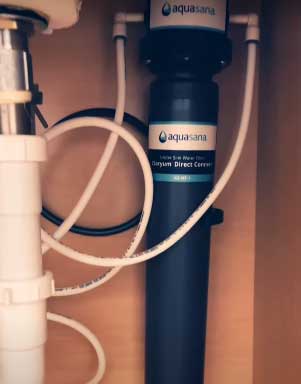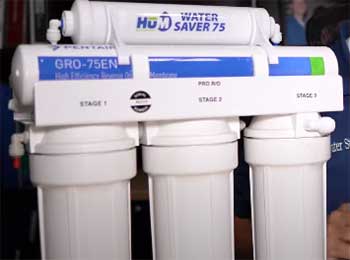When it comes to purifying your drinking water, Claryum and reverse osmosis (RO) are two of the most effective options available today. But how do these two water filters compare, and which one is right for your needs?
This comprehensive guide examines the key differences between Claryum and reverse osmosis, including their purification methods, contaminant removal abilities, and ease of use. Read on to learn which water filter comes out on top.
A Brief Comparison Table
| Feature | Claryum | Reverse Osmosis |
| Filtration Stages | 3 stages: carbon block, ion exchange, ultrafiltration membrane | 4-5 stages: sediment prefilter, carbon block, RO membrane, mineral addition post-filter |
| Contaminant Removal | Removes 99.99% of TDS, 99.9999% of bacteria/viruses, 99.99% heavy metals, microplastics, pharmaceuticals | Removes 99% TDS, 99.9% bacteria/viruses, 95-99% heavy metals, partially removes microplastics and pharmaceuticals |
| Water Waste | 1-3 gallons of waste per gallon of filtered water | 2-10 gallons of waste per gallon of filtered water |
| Filtration Speed | Rapid flow produces water 2-3x faster than RO | Slow, produces 1-2 gallons per hour |
| Installation | Easily installs under sink to existing cold water line | Easily installs under sink to cold water line |
| Maintenance | Long-lasting filters (12 months) | More frequent filter changes required (6-12 months) |
| Water Taste | Leaves in natural minerals for refreshed taste | Can produce flat tasting water if minerals not added back |
| Cost | Lower upfront cost of $200-$400 | Higher initial cost, typically $300-$1000 |
| Ease of Use | No storage tank to maintain, fresh water on demand | Storage tank requires disinfecting to prevent bacteria |
How Claryum Water Filters Work?

Claryum water filters utilize a multi-stage filtration process to deeply purify water in your home.
The system uses a combination of activated carbon, ion exchange resin, and an ultrafiltration membrane to remove a wide range of contaminants from water.
The first stage uses activated carbon to filter out chlorine and absorb other chemical contaminants through adsorption.
The second stage contains ion exchange resin beads that attract and trap heavy metals, minerals, and other dissolved solids.
Finally, the ultrafiltration membrane has microscopic pores that block bacteria, viruses, protozoa, and even smaller dissolved contaminants from passing through.
This thorough three-stage process allows Claryum filters to remove up to 99.99% of total dissolved solids (TDS), 99.99% of heavy metals like lead and mercury, 99.9999% of viruses and bacteria, and even emerging contaminants like pharmaceuticals and microplastics.
The end result is refreshing purified water ideal for drinking and cooking.
Also Read: Differences Between Waterdrop And ZeroWater Water Filters.
How Reverse Osmosis Filters Work?
Reverse osmosis utilizes a multi-layer filtration system and high water pressure to force water through a semipermeable RO membrane. This membrane has microscopic pores that block contaminants while allowing water molecules to pass through.
First, a sediment pre-filter traps particles. Then activated carbon blocks chlorine and absorbs chemicals. After this, the pressurized water is forced through the RO membrane. Clean water passes through while contaminants are flushed out the drain line. Finally, a post-filter adds beneficial minerals back before the water is dispensed.
With its tight 0.0001 micron membrane pores, reverse osmosis removes up to 99% of total dissolved solids, 95-99% of heavy metals, 99% of fluoride, 89% of nitrate, and 99.9% of bacteria and viruses. RO also reduces chlorine, pesticides, pharmaceuticals, and other emerging water contaminants.
Comparing Contaminant Removal
Both Claryum and reverse osmosis are highly effective at removing a wide array of inorganic and organic contaminants from water. However, Claryum filtration appears to have a slight performance edge for filtering out some of the most concerning pollutants.
- Heavy Metals
Claryum removes 99.99% of concerning heavy metals like lead, arsenic, mercury, chromium, and cadmium. Reverse osmosis eliminates 95-99% of these toxins.
- Bacteria and Viruses
Claryum filters out 99.9999% of disease-causing bacteria and viruses. RO systems filter 99.9% of these microorganisms.
- Total Dissolved Solids
TDS are minerals, salts, and metals dissolved in water. High TDS water tastes poor and can negatively impact health. Claryum reduces TDS by 99.99%, versus 99% with RO.
- Pharmaceuticals
Emerging water contaminants like pharmaceutical drugs are effectively removed by Claryum but may pass through some RO systems.
- Fluoride
While both systems reduce fluoride levels from water, Claryum appears to be more thorough at removing this compound.
- Microplastics
Microplastics are an emerging health concern in drinking water. Claryum’s ultrafiltration membrane is engineered to trap these tiny plastic particles, while microplastics may penetrate RO membranes.
So while both filtration methods offer excellent contaminant reduction, Claryum water filters appear to have a slight performance advantage, especially for new-age pollutants like pharmaceuticals and microplastics.
Water Waste Comparison

One of the biggest differences between these two technologies is water waste.
Reverse osmosis systems can waste 2-10 gallons of water for every gallon of pure water produced.
This is because RO needs high water pressure and flushes contaminants out a drain line.
Claryum, on the other hand, is engineered for high efficiency.
Claryum systems waste only 1-3 gallons per gallon of purified water produced. This significant water savings makes Claryum a more eco-friendly and sustainable solution.
Less water waste also equals real cost savings on your utility bills.
Filtration Speeds
RO and Claryum both produce excellent quality purified water. However, reverse osmosis is relatively slow, often taking 1-2 hours to produce a gallon of water.
Claryum systems utilize high-flow ultrafiltration membranes that filter water at rapid rates. This allows Claryum to produce purified drinking water 2-3x faster than comparable RO units. Faster flow means you get great tasting water on demand while avoiding long waits at the sink.
Installation and Maintenance
When it comes to installation, Claryum and RO systems are both designed to easily hook up to your existing cold water line under the kitchen sink. No permanent modifications to plumbing are required. Most units can be self-installed following included directions.
For maintenance, both technologies require periodic filter replacements to maintain performance. However, Claryum filters tend to have a longer lifespan of 1500 gallons or 12 months. RO filter changes are needed every 6-12 months.
Claryum’s quick-change filter cartridges make maintenance fast and frustration-free. Overall, Claryum is engineered to produce pure water for years with minimal upkeep required.
Filtration Byproducts
The filtration process used also impacts the taste and mineral content of the filtered water produced.
Reverse osmosis removes healthy minerals from water. To compensate, RO systems often add mineralization filters. However, the water can still taste flat or flavorless.
Claryum’s combination of carbon filtration and ultrafiltration leaves beneficial calcium and magnesium intact, for naturally mineralized flavor. The water tastes light and refreshing.
RO water can also frequently have higher TDS from the plastic tubing and storage tank. Claryum systems utilize BPA-free supply lines and have no tank, resulting in lower TDS for better purity.
Cost Comparison
Both Claryum and RO systems require an upfront investment. However, Claryum filters tend to cost less than comparably performing reverse osmosis units.
For example, high-end undersink RO systems often cost $300-$1000. In contrast, Claryum filters are priced between $200-$400. Claryum delivers superior water purity for less upfront cost.
Operationally, Claryum filters last longer between filter changes, saving you money on replacement filters yearly. And reduced water waste equals significant water bill savings when using a Claryum system.
Ease of Use
Operationally, both technologies take water from an existing cold water line and route it through multi-stage filtration housings. Purified water is then dispensed from a dedicated kitchen faucet. Used in this way, RO and Claryum systems have very similar ease of use.
However, reverse osmosis systems frequently utilize storage tanks that can breed bacteria without proper sanitization. This adds an extra maintenance consideration.
Claryum systems produce filtered water instantly on demand. There is no storage tank to sanitize or maintain. This results in fresher water with less effort overall.
Frequently Asked Questions (FAQ)
Yes, Claryum water filters are an advancement beyond traditional reverse osmosis technology. Claryum utilizes a three-stage filtration process with activated carbon, ion exchange resin, and an advanced ultrafiltration membrane. This allows Claryum filters to remove more dissolved solids, heavy metals, microplastics, pharmaceuticals, fluoride, and other pollutants compared to RO. Claryum also wastes far less water and produces fresher, mineralized drinking water.
Claryum systems use a multi-stage filtration process to deeply purify your drinking water. First, activated carbon blocks chlorine and absorbs chemicals. Next, ion exchange resin removes dissolved heavy metals and minerals. Finally, the ultrafiltration membrane filters out viruses, bacteria, microplastics, pharmaceuticals and other emerging contaminants. This thorough filtration leaves you with refreshing water free of harsh contaminants.
Claryum water filters are uniquely designed to remove concerning microplastics from drinking water. Microplastics are tiny plastic particles that come from the breakdown of larger plastics. These particles can penetrate traditional RO membranes. But Claryum combines carbon block filtration with a specialized ultrafiltration membrane that traps microplastics as tiny as 0.01 microns in size. This ensures these potential toxins don’t end up in your glass.
PFAS (per- and polyfluoroalkyl substances) are industrial chemicals that contaminate many water supplies. These “forever chemicals” require advanced filtration technology for removal. While effective to some degree, most reverse osmosis systems struggle to remove shorter chain PFAS. Claryum utilizes a highly engineered carbon media and proprietary ultrafiltration membrane that is proven to remove both long and short chain PFAS contaminants from water. For thorough PFAS removal, Claryum is the top choice.
The Bottom Line
While both deliver high quality drinking water, Claryum water filters compare very favorably to reverse osmosis systems. Claryum removes contaminants more thoroughly, wastes far less water, costs less upfront, and produces fresher tasting mineral water instantly on demand.
For deepest purification with the least amount of waste and effort, Claryum is the superior choice over reverse osmosis. Claryum gives you the best tasting, healthiest water for your home.
